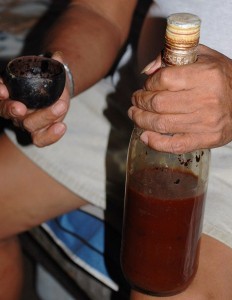 So the idea is that you spend thousands of dollars to fly somewhere exotic, where you ingest substances that make you sick from both ends and get you high, and then you climb on a minibus back to the airport and return to your humdrum reality. No, I’m not talking about all-inclusive resorts in Mexico with unlimited cerveza; rather, I’m talking about the burgeoning industry of ayahuasca tourism in the Amazon, particularly Peru.
So the idea is that you spend thousands of dollars to fly somewhere exotic, where you ingest substances that make you sick from both ends and get you high, and then you climb on a minibus back to the airport and return to your humdrum reality. No, I’m not talking about all-inclusive resorts in Mexico with unlimited cerveza; rather, I’m talking about the burgeoning industry of ayahuasca tourism in the Amazon, particularly Peru.
Ayahuasca is a brew of medicinal plants used by Amazonian shamans since time immemorial, to get high, have visions, perform healings, and generally get in touch with their version of the spirit world. Nowadays it is a commodity in the hands of new-age gringo entrepreneurs—scores of highly lucrative “healing centres” and “spiritual retreats” have sprung up in the jungles of Peru, Colombia and Bolivia, flocked to by westerners in search of themselves. What they pay for is the illusion they are taking part in authentic indigenous rituals, overseen by powerful shamans who will guide them to enlightenment. What they get is a theatrically delivered diet of purges and hallucinogens, which makes them sick and get them stoned. It seems a lot of them feel they get their money’s worth; every so often, however, one of them does not make it home.
The latest fatality took place during an aya ceremony at a retreat called Phoenix Ayahuasca, near Iquitos, Peru, run by a pair of Australians. The victim was a young British financier who attacked a fellow guest with a kitchen knife after imbibing the drug, and had the knife turned against himself in the struggle. The killer was arrested, but released after local police determined he had acted in self-defense. Then he shaved his head in tribute to the deceased, who was apparently a good friend. I don’t follow the logic of that, but then none of it makes sense to me in the first place. It’s all very sad. It also raises some serious questions.
How safe is this drug-happy tourism? There have been a few deaths documented since the “healing centres” explosion took off, but overall it is probably safer than, say, swimming, sky-diving, or running a marathon; I say “probably,” because the risk statistics for ayahuasca tourism do not exist. Two tourists—a Canadian woman and a man from New Zealand died this year after being given tobacco purges intended to clean them out physically and spiritually; an American teenager died in 2012 after drinking ayahuasca, and was summarily buried on the grounds in an effort to hush the death up; a British teenager met a similar fate in Colombia in 2014; two French nationals died in 2011; and anecdotes of others are floating around.
But the risks are not limited to the possibility of dying. Some of the aya tourists go to these “healing centres” because they want to touch the universe or find themselves or be immersed in a richer reality, or similar aspirations, but some are in search of cures for depression or mental and/or physical illnesses. The drugs handed out at these “healing centres” can be powerful, even poisonous—and are known to have potentially lethal cross-effects with other medications, and to be highly risky for people with certain chronic conditions. But the drugs are not regulated. The people handing them out are not regulated. And whatever glowing claims are made about the wisdom and experience of the shamans hired by the retreats, it is clear that the field is full of charlatans and opportunists. While bad trips, psychotic episodes, and cases of brain damage have been recorded, nobody can reliably estimate the scale of the risk. And then there’s the other sense of “bad trip,” where guests in jungle retreats have been ripped off, abused, sexually harassed, terrorized, and even raped.
Some holiday. And yet, hordes of happy tourists swear by these spirit-expanding vacations, even with the semi-mandatory vomiting. They’re welcome to them. Myself, I’d be happy with a beer and a taco by the side of some pool.
